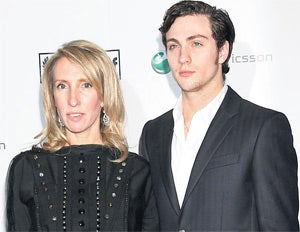Tim Walker: 'Sam Taylor-Wood and Steve McQueen always had an eye on the screen'
The Couch Surfer: A well-known YBA is now almost as commercial a proposition as a pop promo director

Is there any marriage of words less enticing than "art" and "film"?
It brings to mind such cinematic non-events as two clowns jumping up and down ("Double No", Bruce Nauman, 1988); or 90 minutes of Zinedine Zidane in close-up (Zidane, Douglas Gordon and Philippe Parreno, 2006) – an experience as dissatisfying for film lovers as it was for football fans. It's bad enough being a teenage boy, without being dragged on school trips to art galleries to be shown somebody getting a blowjob in black and white ("Blow Job", Andy Warhol, 1963).
So when an "artist" makes a "film", the last thing you'd expect is a straightforward biopic, let alone a biopic about one of history's most familiar rock stars. Yet last week, Sam Taylor-Wood released her debut feature, Nowhere Boy, the story of the young John Lennon.
In the Eighties, many dynamic filmmakers came from TV commercials, among them Alan Parker, Adrian Lyne and Ridley Scott. Some of the most interesting Hollywood pictures of the past decade were made by former music video directors, like Spike Jonze, Michel Gondry and Jonathan Glazer. Now there's a new source of emerging directorial talent: Britain's art scene.
In 2008, Taylor-Wood's fellow YBA Steve McQueen made the acclaimed Hunger. No doubt Nowhere Boy, too, will attract its fair share of Bafta nominations, if only for its magnetic central performance by the director's young beau, Aaron Johnson. McQueen and Taylor-Wood come from a world that would have been seen as decidely non-mainstream until Charles Saatchi turned Damien Hirst et al into celebrities. Thanks to Saatchi – an adman, of course – a well-known YBA is now almost as commercial a proposition as a pop promo director.
Perhaps it should come as no surprise, then, to find them making arthouse-crossover movies, just as Jonze and Gondry did with Being John Malkovich or Eternal Sunshine of the Spotless Mind: challenging, innovative films that nonetheless found a popular audience. When they did video work as artists – such as McQueen's Turner Prize-winning "Deadpan" from 1997, or Taylor-Wood's tabloid-friendly 2004 film of David Beckham sleeping, "David" – the two new directors might reasonably have been thought of as aspiring Naumans or Warhols.
As it turns out, they each had at least one eye on the silver screen. Tracey Emin, too, has made a feature film, Top Spot (2004). And one of the most remarkable, brilliant arthouse-crossovers of recent years, 2007's The Diving Bell and the Butterfly, was made by the visual artist Julian Schnabel.
It's striking that each of these filmmakers chose to work in one of the most traditional of Hollywood genres, the biopic. Nowhere Boy, as previously mentioned, is about Lennon; Hunger is about the slow death of IRA hunger-striker Bobby Sands; The Diving Bell and the Butterfly is based on the short memoir of paralysed Parisian magazine editor Jean-Dominique Bauby. Schnabel's two other films, Basquiat (1996) and Before Night Falls (2000), are also biopics – of the New York artist Jean Basquiat and Cuban writer Reinaldo Arenas respectively.
McQueen recently signed up to make a movie about Fela Kuti, the father of Afrobeat. Emin's film was, naturally, about herself. And in its way, even Zidane was a biopic. It showed in intimate detail the things that really ought to interest the footballer's followers: his silky skills, and that dangerous temper. Like the music videos that gave Jonze, Gondry or Glazer their proving ground, "specialist" "art" "films" are rarely as narrative-led as the standard chronological plod of a cinema biopic, so each artist was primed to undermine the genre's conventions. Hence each subject gets decidely offbeat treatment. Taylor-Wood's film, for instance, features not a single Beatles song.
She and McQueen are also beneficiaries of the rise of the "slash career". Fame in one field is enough to be accepted in another: they are artists-slash-filmmakers just as Ethan Hawke is an actor-slash-novelist, Nick Cave a musician-slash-screenwriter-slash-novelist, or Peaches Geldof a model-slash-DJ-slash-entrepreneur. Many film directors have been known to dabble in fine art, after all: Terry Gilliam, Ridley Scott, Peter Greenaway. And as has been mentioned in the press coverage for Avatar, James Cameron – the most macho of all directors, and creator of perhaps the most unlikely "art" "film" of the year – also paints.
Subscribe to Independent Premium to bookmark this article
Want to bookmark your favourite articles and stories to read or reference later? Start your Independent Premium subscription today.

Join our commenting forum
Join thought-provoking conversations, follow other Independent readers and see their replies